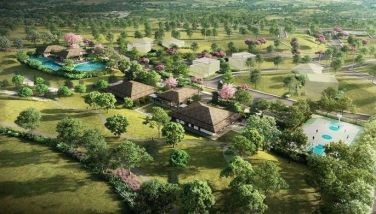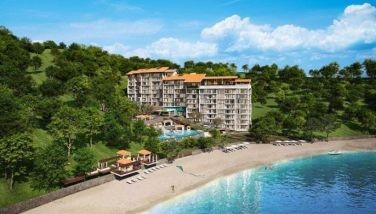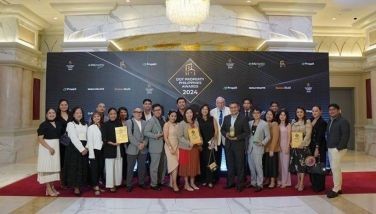Home to Olive Ridley Turtles
February 17, 2006 | 12:00am
Kawayan Cove, a seaside community in Nasugbu, Batangas recently served as the birthplace of 88 olive ridley turtle hatchlings. This is the second turtle hatchling to occur in the beach in two months.
Kawayan Cove’s private, white sand beach is among the few areas in the Philippines where the olive ridley turtles are able to nest safely. In the past, the shore of Manila Bay was among the nesting areas of the pawikans, but because it has become so polluted, noisy and crowded, the turtles abandoned it.
"They’ve been around for millions of years, but are on the brink of extinction now because of human encroachment. They are either taken as food or hunted for their shells, which are converted into accessories such as turtle combs or payneta," said World Wildlife Fund (WWF) representative Joel Palma during his recent visit to the protected turtle sanctuary.
As more nests are expected to be discovered, Kawayan Cove invited the WWF to assess the nesting ground and to solicit more information about the turtles.
WWF inspected the site and revealed that this refuge for beach going city dwellers is also an ideal nesting ground for olive ridley turtles.
"The olive ridley turtles come here to nest because the water is still clean. The quietness of the place also encourages the turtles to lay their eggs here. Loud noise and light frighten nesting mother turtles," observed Palma.
The pristine nature of the water is attributed to a seldom practiced but important technique of creating desilting ponds to prevent construction waste from flowing into the ocean.
"We have separate sewage drainage systems. Water from the sewage and the kitchen are separately treated. This ensures that water that goes back to the sea is clean," Kawayan Cove’s Engr. Avelino Yongoyong pointed out. "We have also complied with or exceeded all the requirements of the Department of Environment and Natural Resources," he said.
Kawayan Cove is serene because there are no other properties sharing the beach and the twin headlands seem to hide its beach from the rest of the neighboring beaches. Crowding has been eliminated by keeping the beach club exclusive to property owners, instead of the usual practice of selling shares. "We want to make sure that everyone who swims here has a material stake in its preservation," said Joey Puyat, president of Kawayan Cove.
During the site inspection, Palma also observed that the lighting in Kawayan Cove is tactical because it provides sufficient illumination yet does not disorient the baby sea turtles as they make their way to the sea.
During the orientation attended by the Kawayan Cove Project Management Team, the WWF representative expressed the importance of turtles in the ecosystem. According to Palma, "Olive ridley turtles are important to the environment because they are part of the food chain. Because they feed on sea grass, they serve as filters for the waters so that photosynthesis can occur. Without them, there will be too much algae floating around."
He also expressed that while one turtle can lay an average of 100 eggs, not many of the hatchlings survive. "The olive ridleys hatchlings a survival rate of one percent so they really should be protected and preserved," Palma underscored.
According to Puyat: "Preserving this place has been a multigenerational effort on the part of my family. Batangas is such a beautiful place and we feel it is our duty to keep it, and everything in it, that way. We want to cascade this sense of responsibility and love for nature to our children."
He added: "My mother has already written a letter to her grandchildren." He excerpted: ‘These turtles were hatched in Kawayan Cove and the next time they will nest will be about 50 years from now. I will no longer be around to see them; but you will.’ "When she read this to her two-year old granddaughter, she said ‘Lola, don’t worry, when I see the turtles, I’ll tell you."
Kawayan Cove’s private, white sand beach is among the few areas in the Philippines where the olive ridley turtles are able to nest safely. In the past, the shore of Manila Bay was among the nesting areas of the pawikans, but because it has become so polluted, noisy and crowded, the turtles abandoned it.
"They’ve been around for millions of years, but are on the brink of extinction now because of human encroachment. They are either taken as food or hunted for their shells, which are converted into accessories such as turtle combs or payneta," said World Wildlife Fund (WWF) representative Joel Palma during his recent visit to the protected turtle sanctuary.
WWF inspected the site and revealed that this refuge for beach going city dwellers is also an ideal nesting ground for olive ridley turtles.
"The olive ridley turtles come here to nest because the water is still clean. The quietness of the place also encourages the turtles to lay their eggs here. Loud noise and light frighten nesting mother turtles," observed Palma.
The pristine nature of the water is attributed to a seldom practiced but important technique of creating desilting ponds to prevent construction waste from flowing into the ocean.
"We have separate sewage drainage systems. Water from the sewage and the kitchen are separately treated. This ensures that water that goes back to the sea is clean," Kawayan Cove’s Engr. Avelino Yongoyong pointed out. "We have also complied with or exceeded all the requirements of the Department of Environment and Natural Resources," he said.
Kawayan Cove is serene because there are no other properties sharing the beach and the twin headlands seem to hide its beach from the rest of the neighboring beaches. Crowding has been eliminated by keeping the beach club exclusive to property owners, instead of the usual practice of selling shares. "We want to make sure that everyone who swims here has a material stake in its preservation," said Joey Puyat, president of Kawayan Cove.
During the site inspection, Palma also observed that the lighting in Kawayan Cove is tactical because it provides sufficient illumination yet does not disorient the baby sea turtles as they make their way to the sea.
During the orientation attended by the Kawayan Cove Project Management Team, the WWF representative expressed the importance of turtles in the ecosystem. According to Palma, "Olive ridley turtles are important to the environment because they are part of the food chain. Because they feed on sea grass, they serve as filters for the waters so that photosynthesis can occur. Without them, there will be too much algae floating around."
He also expressed that while one turtle can lay an average of 100 eggs, not many of the hatchlings survive. "The olive ridleys hatchlings a survival rate of one percent so they really should be protected and preserved," Palma underscored.
He added: "My mother has already written a letter to her grandchildren." He excerpted: ‘These turtles were hatched in Kawayan Cove and the next time they will nest will be about 50 years from now. I will no longer be around to see them; but you will.’ "When she read this to her two-year old granddaughter, she said ‘Lola, don’t worry, when I see the turtles, I’ll tell you."
BrandSpace Articles
<
>
- Latest
Latest
Latest
October 23, 2024 - 9:30am
By May Dedicatoria | October 23, 2024 - 9:30am
October 11, 2024 - 3:45pm
October 11, 2024 - 3:45pm
October 10, 2024 - 11:30am
October 10, 2024 - 11:30am
October 5, 2024 - 12:08pm
October 5, 2024 - 12:08pm
September 24, 2024 - 1:00pm
September 24, 2024 - 1:00pm
September 13, 2024 - 4:00pm
September 13, 2024 - 4:00pm
Recommended




























